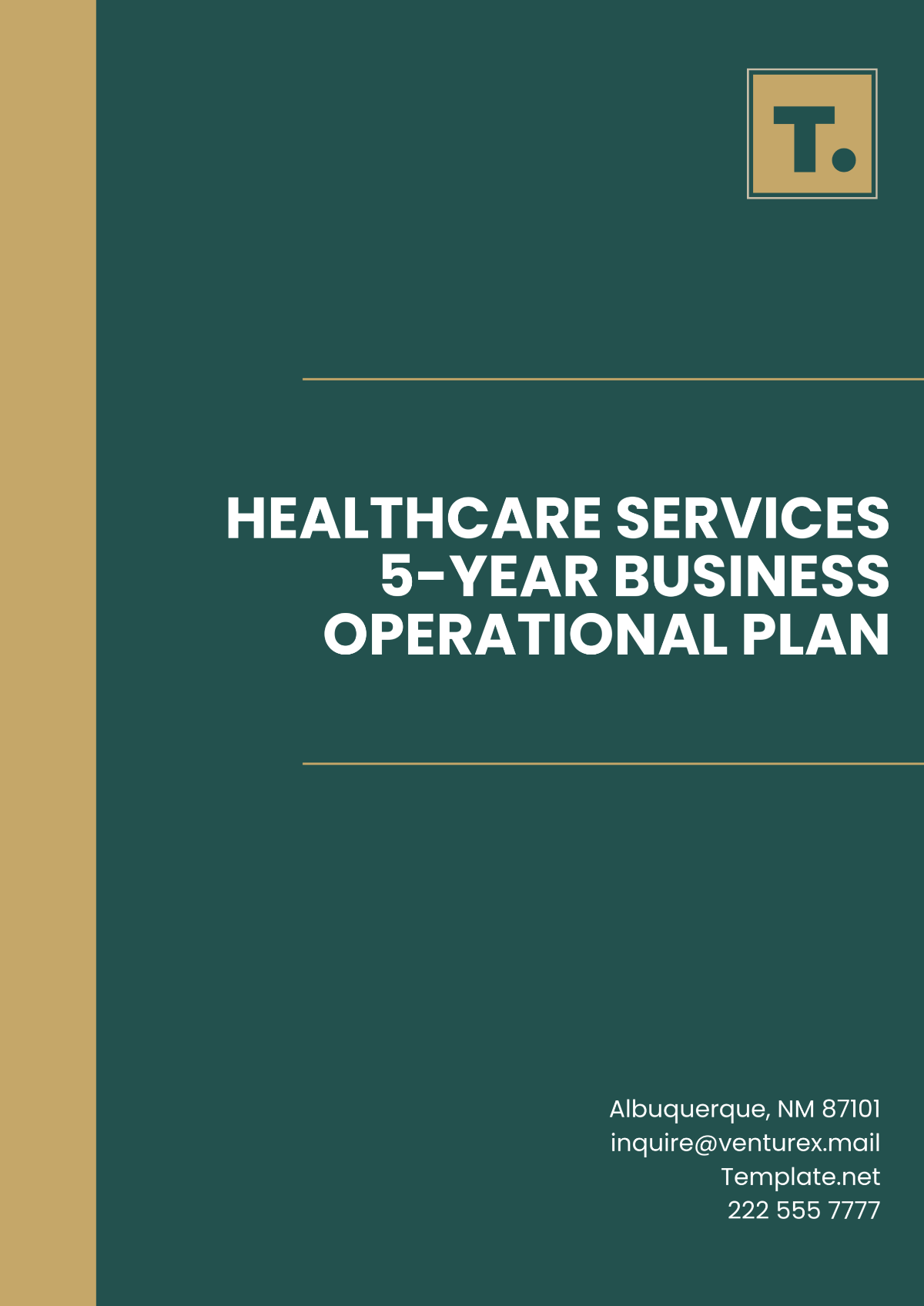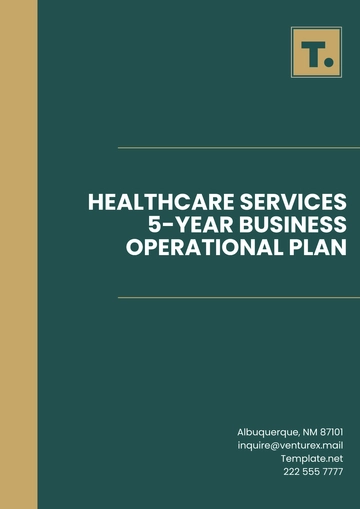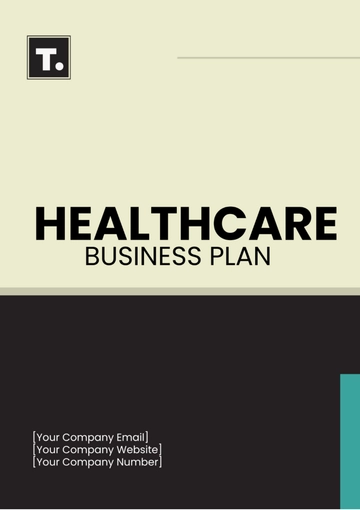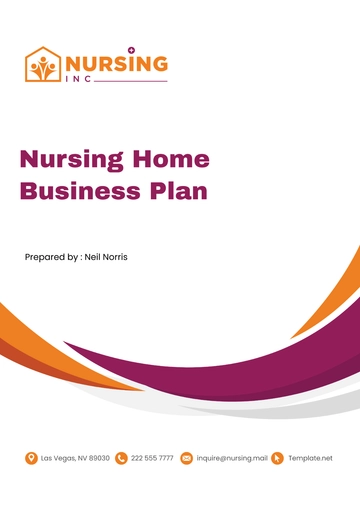Free Healthcare Services 5-Year Business Operational Plan

Prepared By: [Your Name]
Date: June 12, 2060
1. Executive Summary
This operational plan outlines the strategic roadmap for [Your Company Name] from 2060 to 2065. The plan focuses on delivering quality patient care, improving operational efficiency, and expanding our healthcare services to underserved regions. This document provides a detailed approach to achieving sustainable growth through strategic initiatives and robust resource allocation.
2. Mission and Vision Statements
Mission: To provide accessible, high-quality healthcare solutions that enhance the well-being of our communities through innovative treatments, patient-centered care, and advanced medical technologies.
Vision: By 2065, [Healthcare Services Business Name] aims to be a leader in patient care and medical innovation, setting new standards for healthcare quality and accessibility.
3. SWOT Analysis
Strengths:
Established reputation in healthcare delivery
Advanced medical equipment and facilities
Highly skilled medical professionals
Weaknesses:
Limited service reach in remote areas
Dependence on government funding for certain projects
Opportunities:
Increasing demand for healthcare services in aging populations
Technological advancements in telemedicine and digital health
Threats:
Potential policy changes affecting healthcare funding
Rising operational costs and resource shortages
4. Goals and Objectives (2060-2065)
Goal 1: Expand service coverage to reach 90% of underserved areas by 2065.
Objective: Open five new healthcare facilities in remote regions by 2065.
Goal 2: Improve patient satisfaction scores by 20% by 2063.
Objective: Implement patient feedback systems and personalized care programs.
Goal 3: Reduce operational costs by 10% by 2065.
Objective: Adopt AI-driven healthcare management software to optimize resource use.
5. Key Strategies and Initiatives
Strategy 1: Leverage telemedicine to reach remote patients.
Initiative: Partner with tech firms to develop a secure, user-friendly telemedicine platform by 2061.
Strategy 2: Enhance staff training and retention programs.
Initiative: Launch a comprehensive training program for healthcare professionals with a focus on emerging medical technologies by 2062.
Strategy 3: Optimize inventory management and supply chain.
Initiative: Implement AI-based inventory control systems to reduce waste and improve supply accuracy by 2064.
6. Resource Allocation and Budget (2060-2065)
Year 2060: $2 million – Initial investment in technology and telemedicine infrastructure.
Year 2061: $3 million – Expansion of healthcare facilities and equipment.
Year 2062: $1.5 million – Staff training and development.
Year 2063: $2.5 million – Enhanced patient experience initiatives.
Year 2064: $2 million – Implementation of AI-driven inventory management system.
7. Timeline and Milestones
Q1 2060: Launch telemedicine platform in pilot regions.
Q4 2060: Achieve 50% reach in targeted underserved areas.
Q2 2062: Complete staff training on new technologies.
Q3 2063: Reach 75% patient satisfaction improvement goal.
Q4 2065: Finalize expansion and meet 90% underserved area coverage.
8. Risk Assessment and Contingency Plans
Risk 1: Technology adoption delays or failures.
Contingency Plan: Have a backup technology provider and train staff in alternative care methods.
Risk 2: Budget constraints due to funding changes.
Contingency Plan: Allocate reserve funds and seek partnerships with private investors.
Risk 3: Staff shortages impacting service quality.
Contingency Plan: Implement a flexible hiring and cross-training program to manage fluctuating staffing needs.
9. Evaluation and Key Performance Indicators (KPIs)
Patient Satisfaction Rate: Target 85% by 2065.
Service Reach: Achieve 90% coverage of underserved areas by 2065.
Operational Cost Efficiency: 10% cost reduction by 2065.
Staff Retention Rate: Maintain a 90% retention rate for key roles by 2065.
10. Review and Adaptation Process
Annual Review Meetings: Conduct yearly performance reviews to assess progress and adjust strategies.
Mid-term Analysis (Q4 2062): Perform an in-depth analysis to re-evaluate goals and make necessary adjustments based on healthcare industry trends.
End-of-Plan Evaluation (Q4 2065): Conduct a final review to evaluate overall performance against objectives and strategize for future growth.
- 100% Customizable, free editor
- Access 1 Million+ Templates, photo’s & graphics
- Download or share as a template
- Click and replace photos, graphics, text, backgrounds
- Resize, crop, AI write & more
- Access advanced editor
Optimize your healthcare services with a strategic 5-Year Operational Plan Template. Editable and customizable in Template.net’s Ai Editor Tool, it allows you to streamline patient care operations, enhance service delivery, and plan for sustainable growth in healthcare.
You may also like
- One Page Business Plan
- Coffee Shop Business Plan
- Restaurant Business Plan
- Food Business Plan
- Real Estate Business Plan
- Executive Summary Business Plan
- Cover Page Business Plan
- Nonprofit Business Plan
- Daycare Business Plan
- Construction Business Plan
- Startup Business Plan
- Medical Business Plan
- Bakery Business Plan
- Service Plan
- Hotel Business Plan
- Catering Business Plan
- School Business Plan
- Healthcare Business Plan
- Transportation Plan
- Sports Plan
- Car Wash Business Plan
- Salon Business Plan
- Clothing Business Plan
- Farming Business Plan
- Boutique Plan



